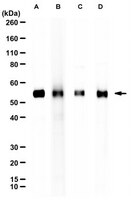MABS2498-100UG Sigma-AldrichAnti-Caspase-8 Antibody, clone C15
Anti-Caspase-8, clone C15, Cat. No. MABS2498, is a mouse monoclonal antibody that detects Caspase-8 and is tested for use in Western Blotting and Immunoprecipitation.
More>> Anti-Caspase-8, clone C15, Cat. No. MABS2498, is a mouse monoclonal antibody that detects Caspase-8 and is tested for use in Western Blotting and Immunoprecipitation. Less<<Recommended Products
Overview
| Replacement Information |
|---|
| References |
|---|
| Product Information | |
|---|---|
| Format | Purified |
| Presentation | Purified mouse monoclonal antibody IgG2b in buffer containing 0.1 M Tris-Glycine (pH 7.4), 150 mM NaCl with 0.05% sodium azide. |
| Quality Level | MQ200 |
| Physicochemical Information |
|---|
| Dimensions |
|---|
| Materials Information |
|---|
| Toxicological Information |
|---|
| Safety Information according to GHS |
|---|
| Safety Information |
|---|
| Storage and Shipping Information | |
|---|---|
| Storage Conditions | Recommended storage: +2°C to +8°C. |
| Packaging Information | |
|---|---|
| Material Size | 100 μg |
| Transport Information |
|---|
| Supplemental Information |
|---|
| Specifications |
|---|
| Global Trade Item Number | |
|---|---|
| Catalogue Number | GTIN |
| MABS2498-100UG | 04065272161497 |
Documentation
Anti-Caspase-8 Antibody, clone C15 SDS
| Title |
|---|
Anti-Caspase-8 Antibody, clone C15 Certificates of Analysis
| Title | Lot Number |
|---|---|
| Anti-Caspase-8, clone C15 - Q4192066 | Q4192066 |







